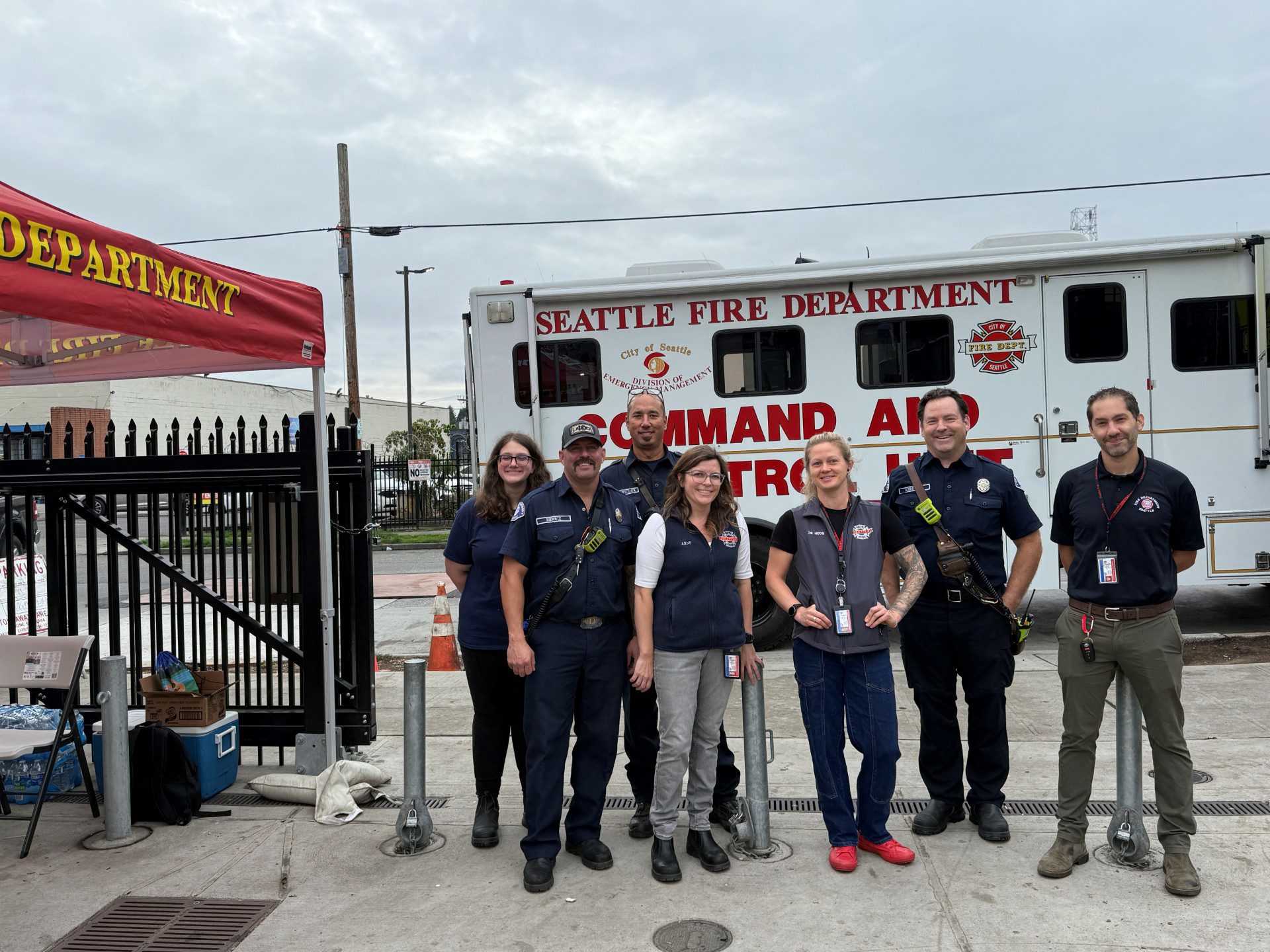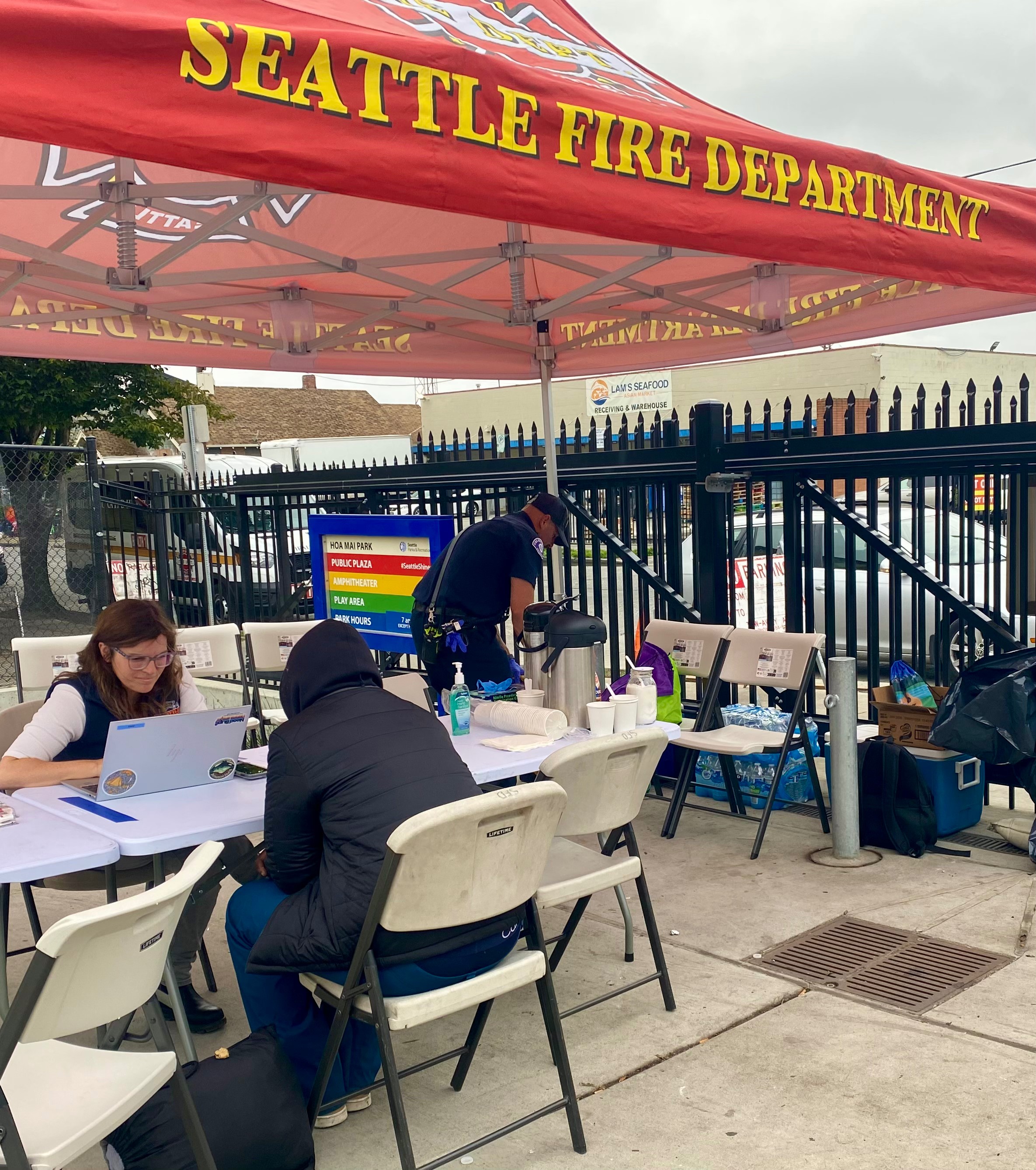

Harborview’s Downtown Programs hosts pop up clinic in Hoa Mai Park
Collaborating for accessible care
 In partnership with the Seattle Fire Department (SFD) and partner agencies, Harborview’s Downtown Programs hosted a four-day pop up clinic at Hoa Mai Park in Seattle’s Little Saigon neighborhood on September 9-12, 2025.
In partnership with the Seattle Fire Department (SFD) and partner agencies, Harborview’s Downtown Programs hosted a four-day pop up clinic at Hoa Mai Park in Seattle’s Little Saigon neighborhood on September 9-12, 2025.
Downtown Programs encompass the network of clinical services available through UW Medicine in downtown Seattle, including the Pioneer Square Clinic, Hobson Place Clinic, and Third Avenue Center. Downtown Programs clinics routinely treat patients from the neighboring community as well as people experiencing homelessness in the area.
The pop-up clinic was designed as an accessible approach to expand addiction treatment in the community. Field-based initiatives such as this reduce barriers to seeking and initiating treatment by providing free, transparent care in familiar and convenient locations.
 The pop up offered individuals with opioid-use disorder a long-acting injection of buprenorphine, a medication that curbs cravings for drugs like fentanyl, without the need for an initial period of withdrawal.
The pop up offered individuals with opioid-use disorder a long-acting injection of buprenorphine, a medication that curbs cravings for drugs like fentanyl, without the need for an initial period of withdrawal.
“Being able start someone on life-saving medication like buprenorphine without the need for an initial period of withdrawal is particularly important for people experiencing homelessness,” said Dr. Jared Klein, associate professor (General Internal Medicine) and medical director of Downtown Programs and the Pioneer Square Clinic.
Buprenorphine is highly effective for treating opioid use disorder, significantly reducing risk of overdose and death.
A recent publication from the Downtown Emergency Service Center (DESC) and UW Medicine demonstrated that a novel method of starting long-acting injectable buprenorphine can be very effective for starting treatment while avoiding opioid withdrawal.
Buprenorphine shots were provided in a series of three injections administered by office-based opioid treatment registered nurses, with the last injection lasting a month. Participants were also provided with food and additional services, such as wound care and naloxone, as well as instructions for follow-up care for subsequent boosters.
The event was led by Downtown Program’s Clinic Manager Cricket Richards McCleary and Jessilyn Haines, ARNP, a Downtown Programs provider embedded with SFD’s Health One & Post-Overdose Response Team. Staffing was provided in partnership with SFD Post-Overdose Response Team firefighter/EMTs, Seattle Human Services Department case managers, DESC’s ORCA Center, and members from the REACH and We Deliver Care organizations.
“The collaboration between SFD and Harborview rapidly put this emerging evidence into practice on the behalf of dozens of vulnerable people experiencing homelessness in downtown Seattle. Our clinical teams and partners will continue innovating and working tirelessly to make addiction treatment available to everyone who needs it,” Klein said.
Community interest and reception
The pop-up clinic was initiated in response to community interest in the medication.
“We are currently responding to more than 60 patients per week experiencing a suspected opioid overdose across the city, and a percentage of those are happening in Little Saigon,” said Seattle Fire Chief Harold Scoggins. “We know there is a strong need to provide low-barrier access to this medication in this community, which is why we brought the long-acting form of buprenorphine to the field.”
During the four days of the pop up, 33 participants started treatment and nearly 200 people were connected with services.
Clinic personnel and case managers have maintained contact with many participants who completed the series through connections with partner organizations and phones that were handed out.
“Most of the clients we worked with are experiencing unsheltered homelessness and have a history of recent incarceration,” said Jessilyn Haines, ARNP.
“Our case management team is actively working to maintain contact to offer support in accessing booster shots at one week and subsequent monthly shots. During this time, they are also assessing goals and trying to connect people to long term case management and appropriate services.”
Through follow up conversations, pop-up organizers learned that several participants not only responded positively to the medication but also were inspired to spread awareness of the treatment to their friends and connections.
One participant, who was later incarcerated, reported an improved experience due to completing the series and not undergoing withdrawal. He reported sharing his experience of getting the shot with others in the jail who expressed interest in treatment.
They have since experienced a major reduction in use and are feeling great.
Another client, despite a difficult start to treatment, completed the series with support from the clinic team and independently received their booster. They have since experienced a major reduction in use and are feeling great. When the clinic team saw them for follow up, they actively promoted the treatment to others in the park, garnering interest from their friends and sharing encouragement.